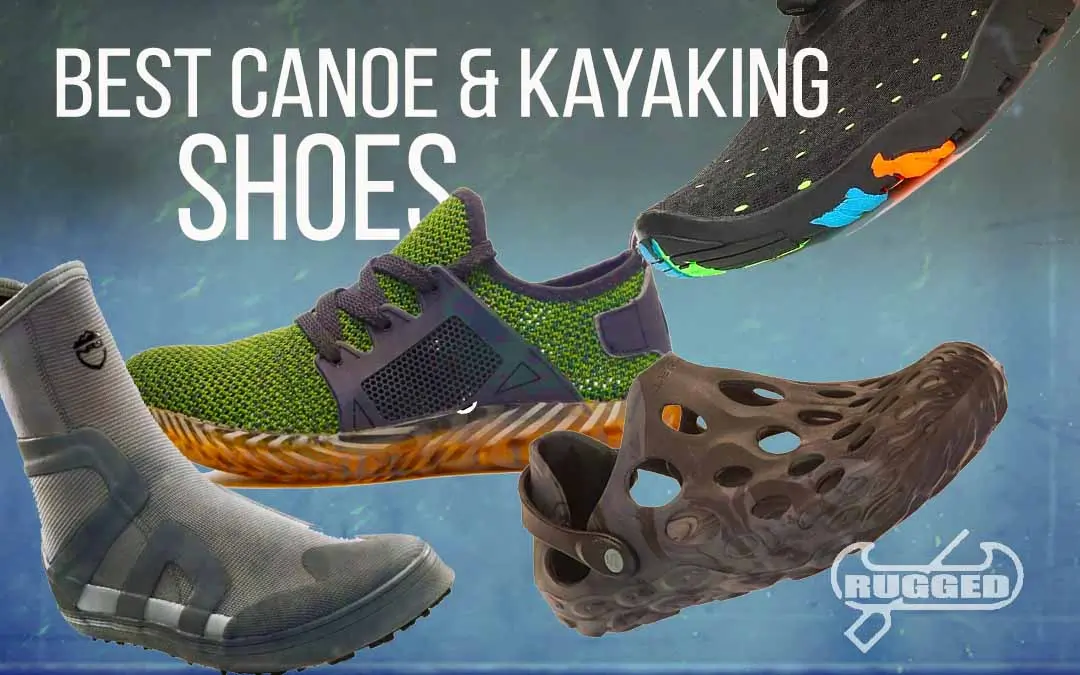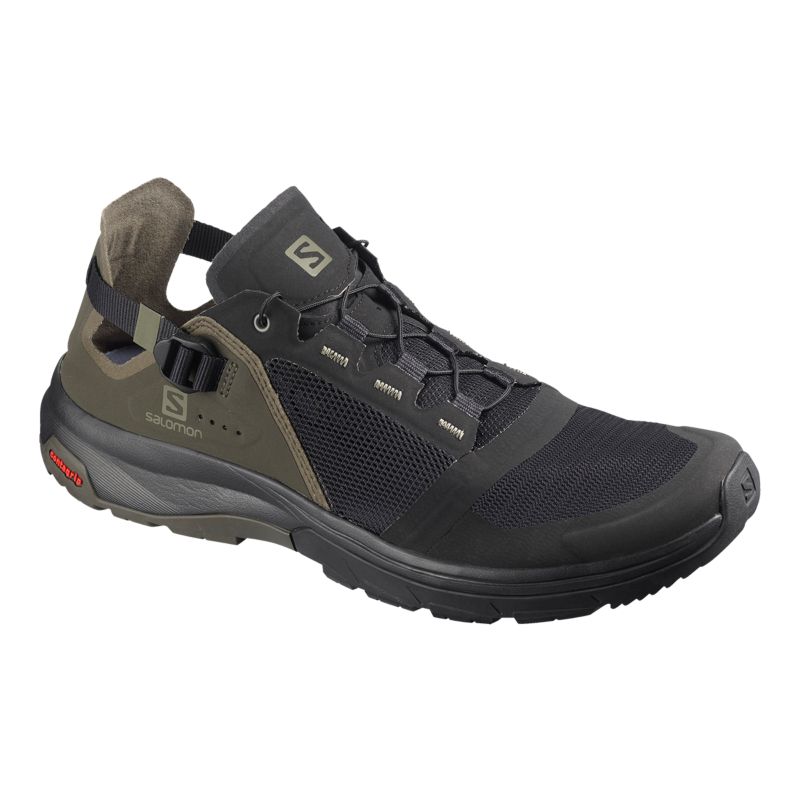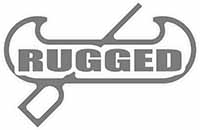One of the more personal choices you’ll make as you plan for your canoe or kayak outing is what to put on your feet. The decision will be based on what type of paddling you’ll be doing, and for how long will you be away from home.
If you’ll be setting up camp on multi-day trips, you’ll want to consider your footwear while you’re at the campsite (which may not be the best shoes for wearing in your boat). Budget concerns might also play a big role in your decisions.
I’ll help you navigate the topic of which shoes are best and I’ll tell you why. I’ve been paddling for over 40 years and I’ll offer you some insight as well as specific shoes that might work for you.
Table of Contents
What Are the Best Shoes for Canoeing?
The best shoes for canoeing are the ones that protect feet and body, as well as offer maximum comfort. This would typically include technical sandals, water shoes, hiking shoes and trail running shoes. The best camp shoes include soft shoes like Crocs or open sandals that can be worn with comfortable wool socks.
Here is a list of shoes that I have either tried out myself or have done the research to find out what purchasers think about them;
We’re also big fans of Salomon’s Amphibian water shoes!
What Are the Best Shoes for Kayaking?
While there are many factors that will ultimately determine the best kayaking shoes for most paddlers in their specific paddling environments, the best general footwear for kayakers would be a neoprene kayak boot or shoe for conditions where wetness is inevitable.
For casual kayakers or kayak anglers who don’t plan on walking in the water or having water soak them, it’s best to consider a sport sandal or foam water shoe, or even a trail running shoe whose sole does not protrude too much.
Tighter, less bulky shoes are best for the confines of a kayak.
Here are some of my best suggestions for kayaking shoes, but remember, kayaking is a sport with huge variables, and it’s important to assess your own situation carefully. Are you challenging whitewater in cold weather in Northern Ontario, Canada? Are you traveling on flat, quiet water in the middle of Summer in Georgia? Are you bass fishing in the Everglades?
Your footwear will NOT be the same in each of those situations.
What Qualities Do I Need in a Kayaking or Canoeing Shoe?
Canoeing and Kayaking shoes should be judged based on a number or criteria that will be more or less important based on conditions. As a rule, the qualities to look for are DURABILITY, PRICE, WEIGHT, PROTECTIVE FEATURES, TRACTION/GRIP, HOW FAST THEY DRY, and BULKINESS.
1 – DURABILITY
Unfortunately, the only real way you can determine this ultimately is to ask people or research peoples’ comments on forums, Amazon, Facebook, etc. To an extent, you can figure out general durability properties by considering the construction materials (rubber is durable but heavy, while foam is not as durable, but light).
You will, unfortunately, have to compromise in many areas which is really what you do with most things in life every day.
2 – PRICE
Price may not be the first thing on some peoples’ list as a determining factor of whether to purchase or not, but for others, it will absolutely be THE MAIN factor.
If you love a pair of Merrells, but the price is $220 for a pair of shoes you’ll wear for 3 days of the year, and you’re struggling to pay rent, I’d say back off and use what you have! You get the picture I’m sure!
3 – WEIGHT
While you may be sitting or kneeling in a canoe all day, and believe that weight is not an issue, I’ll draw on my decades of paddling experience to suggest otherwise.
Heavy shoes are simply annoying to wear, and if you forget about weight in the canoe, you’ll immediately remember the moment you step onto shore! I own a pair of VERY DURABLE Kodiak closed-toe sandals that weigh 572 grams … EACH!
That is WAAAY too heavy … like twice the weight that would be barely acceptable. The durability is stellar, but they are annoyingly heavy, so I simply don’t wear them.
4 – PROTECTIVE FEATURES
I don’t even own an open-toe sandal like a typical Teva sandal. Personally, I like to protect my entire foot (especially when I’m stepping around on rocks in the rapids to slogging through the muck on the lake bottom).
Furthermore, I find that the little section under your toes on open-toed sandals often gets caught on obstacles while you’re on the trail or navigating rocks in a stream. It flips under your foot and causes you to lose balance and it causes serious damage (if it happens repeatedly) to the sandal.
Go for a closed-toe sandal with durable rubber toe or a water shoe like a Salomon or Merrell that looks like a jogging shoe. They will offer the best protection.
If you plan on keeping mostly dry (you don’t always have to jump out of your canoe before it reaches land), then I’d go for a pair of durable, comfortable hiking shoes or boots (depending on the time of year).
5 – TRACTION / GRIP
I love foam sandals that fit relatively tight. Crocs are no good for in the boat because of their bulkiness (not weight). The problem is that unless you are very diligent to get rubber soles, you’ll end up with a cheap pair of foam shoes with foam soles.
Foam soles are a disaster waiting to happen as they have no grip on wet rocks. Any water shoes with a rubber sole should do the trick, but it’s even better if you can find a pair of shoes with a rubber sole AND aggressive tread.
6 – DRYING SPEED
It does very little good to have comfortable shoes that have excellent grip, protection, weight, and even a great price if they never dry once they’re wet!
On a canoe camping trip, you’ll never have more than one evening, night, and early morning to dry your shoes before you’re on the water again.
It’s a great idea to test how fast they dry under varying conditions before you take them on a trip. Foam shoes are the best because they take about 1 – 2 minutes to dry in the sun (or by a warm fire). Other shoes are acceptable if they are made for water and advertise their “quick-dry” abilities.
7 – BULKINESS
The absolute worst shoes for this would be Crocs. They have awesome weight characteristics (light) but they are usually very wide and bulky (not to mention their poor ability to fasten securely to your foot).
I used to own a pair of sandals from both CATERPILLAR and KODIAK. Both were VERY durable, but they were excessively heavy, but even more importantly, BULKY.
Bulkiness is a problem in a canoe because your safety could be tested. If your shoe gets caught on your gear as you try to move or gain your balance, you could end up in the water, or worse!
If you paddle a solo canoe, you can be sure that bulky sandals or footwear will make it nearly impossible to easily move your feet back and forth under your (already low) seat. I know this from first-hand experience when I move from sitting to kneeling in my solo Kevlar tripping canoe.
Footwear that fits close to your foot (not necessarily tight-fitting) is always the best …. ALWAYS!
What Do the Experts Say?
It’s one thing for me to tell you what I think about the best types of footwear for paddle sports, but what do others say? I don’t look too much at other bloggers online because they tend to copy content from other sites.
I went right to some legitimate sources. I researched some well-known authors and outdoorsmen with credibility and sought their opinion.
Bill Mattos and Jeremy Evans are well-qualified writers who can offer us some excellent opinions and ideas. In fact, Bill is a pro kayaker, photographer, businessman, and prolific outdoor writer, while Jeremy is an action sport and yachting journalist.
Both have written much about canoeing and kayaking, and they say, that you “cannot paddle well if you are wearing heavy and cumbersome footwear”.
You cannot paddle well if you are wearing heavy, cumbersome footwear, although bare feet are not ideal either.
Bill Mattos and Jeremy Evans
Old sneakers or runners are often recommended, but they can be bulky and the rubber soles and stick on the inside of the boat.
In warm weather, technical sandals may be appropriate. Otherwise wetsuit boots are best, although they will add to the cost of kitting yourself out.
Specialist water-sport shoes are a good alternative to wetsuit boots. They are non-slip and are ideal for wet surfaces and often have straps to keep them firmly on your feet.
Camp Shoes
If you’re on a multi-day canoe or kayak expedition, it’s always a good thing to let your boat shoes dry out by the fire after a long day on the water.
While they are drying and you’re making dinner, it sure would be nice to have a pair of shoes on your feet. I know I’ve been less than complimentary of Crocs in much of this article, but here’s where they shine.
Crocs are excellent camp shoes since they are loose-fitting and comfortable. They offer unmatched airflow and they are among the lightest shoes available anywhere for any purpose.
Another type of shoe that works very well at the campsite is a pair of Teva or other minimalist, open-toe sports sandal.
Both the sandal and the Croc have the ability to be worn comfortably with a pair of Merino wool socks which wick moisture, dry quickly, breathe, but are supremely warm at the same time. If you combine any one of these shoes with the socks, you’ll have the most comfortable and practical footwear for camp that you can buy.
Shoes for Hiking During Your Canoe/Kayak Expedition
For many, hiking is an integral part of any day trip or multi-day outing on the water. Even if it’s not, it’s comforting to have a versatile, tough water shoe that’s comfortable and that is a great all-around paddle expedition performer.
To that end, here are the 2 best Water Shoe Hikers we’ve found:
Shoes NOT to Wear on a Kayaking or Canoeing Trip
With all the excellent paddling shoe options to choose from, there are some very poor choices that I might steer you away from if possible. Here’s a short list of shoes and why you should NOT use them on a canoe camping trip or kayak excursion.
One final caveat; If these are all you have, you can survive with them just fine if the conditions are good and all goes well. If they are all you have, then don’t cancel your trip just because you don’t have the “right” shoes.
1 – FLIP-FLOPS
Flip-flops are often comfortable and affordable. The problem is that they can cause more problems than they prevent, and nothing about them (other than having a protective sole) is made for wilderness terrain or kayak interiors.
They don’t fit snugly to your foot so they will (yes, WILL) fall off your feet at some point in the canoe or kayak. They can easily slide off your foot while stepping onto shore and that could be disastrous.
Having no support whatsoever, an ankle twist is a very likely injury you’ll sustain at some point, so I’d suggest staying away from them right from the start. Leave them at home – they’re perfect for the backyard or pool deck.
2 – Canvas Hikers or “running shoes”
Once again, you can wear runners if that’s all you have, but most “running shoes” are meant exclusively for running. That means they often have edges that stick out from the bottom of the soles for stability while running, but those “sticky-outy” edges are annoying in a canoe. They catch on your gear and make you lose your balance.
Runners are often not “quick-dry” because that quality is not a priority for marathoners, so that function or quality is not built-in.
Best Kayaking Shoe Takeaways and Final Tip
I’ve mentioned wool socks a few times in this article and it’s important you don’t miss that point. If your budget is restricted, you can get thick, polyester socks that can work for sleeping comfort and warmth as well as camp use, but it’s crucial you keep them dry.
If you get a pair of Merino wool socks and use them only for camping, they should last a lifetime. They wick moisture, dry quickly, provide warmth even when wet, and are quite durable (as mentioned earlier). You can start your research on Amazon (the world’s largest marketplace) or anywhere else you like.
Here’s a pair I really like if you’re curious!
American-made – Minus33 Merino Wool Clothing Mountain Heritage Full Cushion Boot Socks
Above all, remember these 2 points:
Build your paddling wardrobe slowly (unless you have tons of money) since much of your wardrobe is not “necessary”, but rather “nice to have”.
Also, remember that with some basic gear and a less ambitious trip, you can still enjoy the beauty of God’s creation without breaking the bank or stressing over a lack of gear!


















